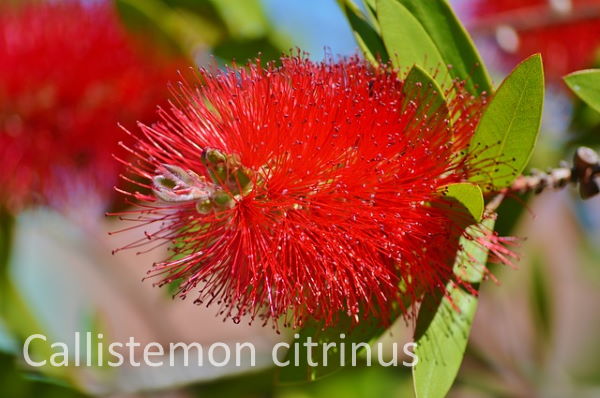Crimson Bottle Brush Plant
Looking for an unusual house plant? Bottle Brush Plant is sure to grab attention -- and admiration -- from all who see it. It's also attractive to butterflies and hummingbirds, if you choose to put it on your porch or patio for the summer.
Find out how to grow this Aussie native, including how to get the most blooms, the best time to prune it back, when to repot, and much more.
 This Aussie native produces captivating red blooms in summer. Image source
This Aussie native produces captivating red blooms in summer. Image sourceGet to Know Bottle Brush Plant
Known botanically Callistemon citrinus, this eye-catching evergreen plant has origins in Australia.
How big does it get? In its native habitat, Callistemon citrinus is a large shrub, growing up to 16 ft (5 m). However, contained to a pot, it is easily kept to 4 ft (1.2 m) indoors. Yearly pruning will keep it compact. Want a smaller houseplant? Callistemon citrinus 'Little John' is a dwarf bottle brush variety, reaching only 3 ft (90 cm) tall.

Given enough light, the Bottle Brush Plant will readily produce upright flower spikes in spring and summer.
It doesn't actually have petals. Each "bottle brush" flower is made up of bright-red stamens with yellow tips, clustered on flower spikes up to 4 in (10 cm) long. At the top of each fuzzy spike is a tuft of leaves.
Each woody stem is covered top to bottom with long, narrow leaves. The dark-green leaves are pointed at the tips and grow upward, giving this captivating plant a lean, elegant look. Callistemon citrinus has a fragrant, lemony scent, giving it another common name: Lemon Bottlebrush.
An Aussie native, this evergreen shrub will do best with bright sun, warm temperatures and dry air. Give it good care, and it will become a fairly large shrub. However, you can keep it compact with regular pruning. Dwarf bottle brush makes a good container plant. Callistemon citrinus 'Little John' is a dwarf cultivar, reaching only 3 ft (90 cm) tall.
Year-Round Care for Bottle Brush Plant
Make it bloom. It'll make an easy indoor plant, if you can provide the sunlight Bottle Brush needs to grow and bloom. Place Bottle Brush Plant directly in front of a sunny window. Or move your plant outdoors for the summer, if you want. Just be sure to bring it back inside when the nighttime temperature drops to 45°F/7°C. This Australian native won't tolerate the cold.
Prune it. Immediately after flowering is over, cut the plant back by half to keep it compact. Use sharp pruners to avoid tearing at the stems, which can harm the plant.
Give it a rest. Callistemons need a winter rest. Keep the plant in a cool place (with a minimum of 45°F/7°C). Cut back on watering during this time, keeping the soil only slightly moist.
Repot in spring. Bottle Brush Plant blooms best when slightly pot-bound, so move it to a slightly larger pot only every couple years or when needed. When the plant reaches the size you want, you can keep it small by repotting it in the same container, just to refresh the soil.
Something bugging your bottle brush plant? Not many pests bother bottle brush indoors, but there are a couple to watch for. Scale are flat, oval, brown insects that feed off the sap of plants. Left unchecked, they can do a lot of damage to a houseplant. Find out how to get rid of scale insects, and be sure to isolate any infested houseplant to prevent pests from invading your other indoor plants. Another to watch for is spider mites. These spiders are about the size of pepper flakes; you probably won't notice an infestation until they have spun their webs between stems and leaves.
 Crimson Bottle Brush Plant makes a captivating houseplant. Photo © Dreamstime.com
Crimson Bottle Brush Plant makes a captivating houseplant. Photo © Dreamstime.comCrimson Bottle Brush Plant Care Tips

Light: Full sun. Plants that don't bloom aren't getting enough light. Give Bottle Brush Plant as much light as you can year-round. A sunroom or a sunny spot directly in front of a window is ideal.
Water: Water thoroughly spring through fall and allow the soil to dry out between waterings. Reduce watering in the winter, while Bottle Brush plant is resting. It's drought-tolerant, so if in doubt about watering, keep it on the dry side. Yellow leaves are a symptom of overwatering and may indicate root rot.
Humidity: Average indoor (around 40% relative humidity). It will tolerate dry air.
Temperature: Average room (65-75°F/18-24°C). It's hardy in USDA Zones 9-10, so it can take the summer heat. Give it a cool rest in winter with a minimum temperature of 45°F/7°C.
Soil: Well-drained soil. Use 2 parts all-purpose potting mix and 1 part horticultural sand.
Fertilizer: Feed monthly spring and summer with high-potassium liquid fertilizer diluted by half.
Propagation: Take 3 in (7 cm) stem tip cuttings in spring or early summer. Can also be sown by seed in spring.


